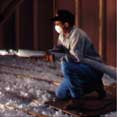
Energy-Saving Home Improvements
Consider these home improvements to help lower your electric bills.
Maintain appropriate levels of insulation in your attic and walls and under your wood frame flooring. As heat moves from hot to cold areas, the insulation will create a barrier of resistance to increase your home’s energy efficiency. When deciding which type of insulating material to buy, keep in mind that the R-factor reflects the amount of resistance the material possesses; the higher the R-factor, the greater the insulating power. Take into account your climate, home design and budget when selecting the insulation R-value.
Weatherize your home by caulking and weather-stripping around windows and doors and wherever plumbing or wiring penetrates through exterior walls, floors or ceilings. This will make a difference in your heating and cooling bills by making sure that the air inside stays in and the air outside stays out. Another step to consider is installing storm windows over single-pane windows or replacing your single-pane with double-pane windows to reduce drafts and condensation.
Use ventilation to remove excess heat and moisture from your home. Gable vents, ridge/soffit vents, thermostatically controlled power ventilators and turbine ventilators can all help control moisture buildup and reduce heat loads on your air conditioning system.
Replace older major appliances such as your refrigerator, dishwasher, washing machine and water heater with new energy-efficient appliances that are less costly to operate.
Use landscaping to help keep energy costs down by planting trees or shrubs to shade air conditioning units. A shaded unit uses as much as 10% less electricity as one that operates in the sun. (Just be careful that the landscaping does not block the airflow.)
